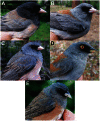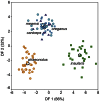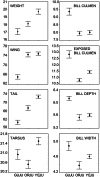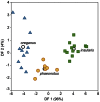Speciation on oceanic islands: rapid adaptive divergence vs. cryptic speciation in a Guadalupe Island songbird (Aves: Junco)
- PMID: 23675466
- PMCID: PMC3651090
- DOI: 10.1371/journal.pone.0063242
Speciation on oceanic islands: rapid adaptive divergence vs. cryptic speciation in a Guadalupe Island songbird (Aves: Junco)
Abstract
The evolutionary divergence of island populations, and in particular the tempo and relative importance of neutral and selective factors, is of central interest to the study of speciation. The rate of phenotypic evolution upon island colonization can vary greatly among taxa, and cases of convergent evolution can further confound the inference of correct evolutionary histories. Given the potential lability of phenotypic characters, molecular dating of insular lineages analyzed in a phylogenetic framework provides a critical tool to test hypotheses of phenotypic divergence since colonization. The Guadalupe junco is the only insular form of the polymorphic dark-eyed junco (Junco hyemalis), and shares eye and plumage color with continental morphs, yet presents an enlarged bill and reduced body size. Here we use variation in mtDNA sequence, morphological traits and song variables to test whether the Guadalupe junco evolved rapidly following a recent colonization by a mainland form of the dark-eyed junco, or instead represents a well-differentiated "cryptic" lineage adapted to the insular environment through long-term isolation, with plumage coloration a result of evolutionary convergence. We found high mtDNA divergence of the island lineage with respect to both continental J. hyemalis and J. phaeonotus, representing a history of isolation of about 600,000 years. The island lineage was also significantly differentiated in morphological and male song variables. Moreover, and contrary to predictions regarding diversity loss on small oceanic islands, we document relatively high levels of both haplotypic and song-unit diversity on Guadalupe Island despite long-term isolation in a very small geographic area. In contrast to prevailing taxonomy, the Guadalupe junco is an old, well-differentiated evolutionary lineage, whose similarity to mainland juncos in plumage and eye color is due to evolutionary convergence. Our findings confirm the role of remote islands in driving divergence and speciation, but also their potential role as repositories of ancestral diversity.
Conflict of interest statement
Figures







Similar articles
-
Change in sexual signalling traits outruns morphological divergence across an ecological gradient in the post-glacial radiation of the songbird genus Junco.J Evol Biol. 2020 Sep;33(9):1276-1293. doi: 10.1111/jeb.13671. Epub 2020 Jul 23. J Evol Biol. 2020. PMID: 32603490
-
Rapid postglacial diversification and long-term stasis within the songbird genus Junco: phylogeographic and phylogenomic evidence.Mol Ecol. 2016 Dec;25(24):6175-6195. doi: 10.1111/mec.13911. Epub 2016 Dec 7. Mol Ecol. 2016. PMID: 27862578
-
Repeated evolution on oceanic islands: comparative genomics reveals species-specific processes in birds.BMC Ecol Evol. 2024 Nov 8;24(1):140. doi: 10.1186/s12862-024-02320-4. BMC Ecol Evol. 2024. PMID: 39516810 Free PMC article.
-
Colonization and diversification of Galápagos terrestrial fauna: a phylogenetic and biogeographical synthesis.Philos Trans R Soc Lond B Biol Sci. 2008 Oct 27;363(1508):3347-61. doi: 10.1098/rstb.2008.0118. Philos Trans R Soc Lond B Biol Sci. 2008. PMID: 18782729 Free PMC article. Review.
-
Phylogenetic divergence of island biotas: Molecular dates, extinction, and "relict" lineages.Mol Ecol. 2019 Oct;28(19):4354-4362. doi: 10.1111/mec.15229. Epub 2019 Sep 23. Mol Ecol. 2019. PMID: 31544990 Review.
Cited by
-
What Darwin could not see: island formation and historical sea levels shape genetic divergence and island biogeography in a coastal marine species.Heredity (Edinb). 2023 Sep;131(3):189-200. doi: 10.1038/s41437-023-00635-4. Epub 2023 Jul 3. Heredity (Edinb). 2023. PMID: 37400518 Free PMC article.
-
Molecular genetic analysis of two native desert palm genera, Washingtonia and Brahea, from the Baja California Peninsula and Guadalupe Island.Ecol Evol. 2017 May 30;7(13):4919-4935. doi: 10.1002/ece3.3036. eCollection 2017 Jul. Ecol Evol. 2017. PMID: 28690819 Free PMC article.
-
Genotyping by sequencing reveals contrasting patterns of population structure, ecologically mediated divergence, and long-distance dispersal in North American palms.Ecol Evol. 2018 May 8;8(11):5873-5890. doi: 10.1002/ece3.4125. eCollection 2018 Jun. Ecol Evol. 2018. PMID: 29938100 Free PMC article.
-
Gonads and the evolution of hormonal phenotypes.Integr Comp Biol. 2016 Aug;56(2):225-34. doi: 10.1093/icb/icw050. Epub 2016 Jun 1. Integr Comp Biol. 2016. PMID: 27252189 Free PMC article.
-
Cryptic Hybridization Dynamics in a Three-Way Hybrid Zone of Dinopium Flamebacks on a Tropical Island.Ecol Evol. 2024 Dec 23;14(12):e70716. doi: 10.1002/ece3.70716. eCollection 2024 Dec. Ecol Evol. 2024. PMID: 39717648 Free PMC article.
References
-
- Whittaker RJ, Fernández-Palacios JM (2007) Island biogeography: ecology, evolution and conservation. New York: Oxford University Press; 304p.
-
- Grant PR (1998) Evolution on islands. Oxford, U.K.: Oxford University Press; 352p.
-
- Coyne JA, Orr HA (2004) Speciation. Sunderland, Massachusetts: Sinauer Associates, Inc.; 545p.
-
- Price T (2008) Speciation in birds. Greenwood Village, Colorado: Roberts and Company; 470p.
-
- Losos JB, Ricklefs RE (2009) Adaptation and diversification on islands. Nature. 457(7231): 830–836. - PubMed
Publication types
MeSH terms
Substances
LinkOut - more resources
Full Text Sources
Other Literature Sources

